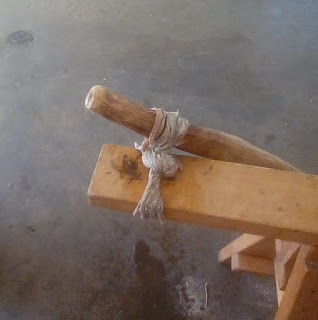On Sharpening A Knife
Always be careful with sharp things.You can get a flesh wound - it will heal, (be careful of infection); but, you can also sever a tendon and that needs immediate medical attention or you’ll lose mobility of whatever it moved - assume how I know.
If you find yourself pushing the edge of a blade into an object or otherwise not slicing - stop, sharpen, or figure out how to reach a material that can be sliced. If it wont cut - stop! A ready knife hardly needs a sawing motion.
I used to have a long article about this, but this is really what you need to know.
Grind off bevel with a Nicholson file (will dull the file fast), concrete (use a lot of weight), sandstone (messy), dimond angle grinder (WARNING- use in brief strokes and cold water dip often while cutting. I use this often because I like to make my own knives from cheap circular saw steel; if you have thin well made knives, using a power tool should be avoided as it's easy to ruin the temper of the edge), diamond file often.
Then, use a creamic "whet stone" from spider co, dimond hone, or any fine grit thing, to put the leading edge on in only a few seconds of well focused rubbs. Maintain the same angle - all the time; this would benifit from being about 22 degrees.
Once the edge of the blade is sharp and will pass for meat cutting, it's time to turn it to a glass sharp edge - the final, mandatory step is strop. You can use a peice of cardboard, but what works far better is a thick strip or thong of bucked, smoked, moose hide; a thick suede thong or a thick flesh side commercial hide will do too. A thick long thong of bucked moose hide is far more moble than a strip glued to a wood board. Tie as shown to a branch or other stationary poll, pull and hold taught, and slowly, carefully, and thoughtfully, run the blade, spine leading, side near flush angle with the leather, back and forth; without question or doubt, this is how natives, frontiersmen, and many more made the most of a steel. You will quickly feel the leather cleaning and polishing the rough honed edge of your tool. No compound required.
The best leather I have used is heavy moose thong from the periodically stiff borders or a moose bucked hide; this type of leather will last a long time, stand the strain of tearing off tough burrs formed from your apexed tools and putting that terrifying glass edge on.
Move toward, more strands (2-5), thicker/denser hide, and a more stationary mount.
Stropping is really the most important step to making a useful knife.
Stropping often will extend the life of your tool. Fewer honing sessions and even fewer grinding sessions.
People get tired of knives because, for whatever reason neglect to keep the pace of chew grinding the bevel with the sharpening of the secondary bevels and leading edge. Grind down the steel, and find useful life again in the chunk of metal.
The keys are three: grind bevel when needed with something aggressive, keep your hone clean and this is done with lye water for the whet stone, and strop often.
Don't stand there massaging at a hone or 200$ rock for a half hour.
Get a good tool from a high carbon 10xx's steel to last.
My axe is self made from a circular saw steel; the steel is soft but to sharpen in the bush, I find a large granite stone with a flat face, grind down hard, lightly lick the edge on the same surface, and then take it to a piece of leather to get a shaver back. I grind down bevel on a grinder before an extended outing.



